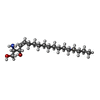[English] 日本語
 Yorodumi
Yorodumi- PDB-6z6w: Poliovirus type 3 (strain Saukett) stabilised virus-like particle... -
+ Open data
Open data
- Basic information
Basic information
| Entry | Database: PDB / ID: 6z6w | ||||||
|---|---|---|---|---|---|---|---|
| Title | Poliovirus type 3 (strain Saukett) stabilised virus-like particle (PV3 SC8) from a mammalian expression system. | ||||||
 Components Components |
| ||||||
 Keywords Keywords | VIRUS LIKE PARTICLE / Capsid protein | ||||||
| Function / homology |  Function and homology information Function and homology informationcaveolin-mediated endocytosis of virus by host cell / symbiont-mediated suppression of host cytoplasmic pattern recognition receptor signaling pathway via inhibition of RIG-I activity / symbiont-mediated suppression of host cytoplasmic pattern recognition receptor signaling pathway via inhibition of MDA-5 activity / symbiont-mediated suppression of host cytoplasmic pattern recognition receptor signaling pathway via inhibition of MAVS activity / picornain 2A / symbiont-mediated suppression of host mRNA export from nucleus / symbiont genome entry into host cell via pore formation in plasma membrane / picornain 3C / T=pseudo3 icosahedral viral capsid / ribonucleoside triphosphate phosphatase activity ...caveolin-mediated endocytosis of virus by host cell / symbiont-mediated suppression of host cytoplasmic pattern recognition receptor signaling pathway via inhibition of RIG-I activity / symbiont-mediated suppression of host cytoplasmic pattern recognition receptor signaling pathway via inhibition of MDA-5 activity / symbiont-mediated suppression of host cytoplasmic pattern recognition receptor signaling pathway via inhibition of MAVS activity / picornain 2A / symbiont-mediated suppression of host mRNA export from nucleus / symbiont genome entry into host cell via pore formation in plasma membrane / picornain 3C / T=pseudo3 icosahedral viral capsid / ribonucleoside triphosphate phosphatase activity / host cell cytoplasmic vesicle membrane / viral capsid / nucleoside-triphosphate phosphatase / channel activity / monoatomic ion transmembrane transport / host cell cytoplasm / DNA replication / RNA helicase activity / symbiont-mediated suppression of host gene expression / symbiont-mediated activation of host autophagy / RNA-directed RNA polymerase / cysteine-type endopeptidase activity / viral RNA genome replication / RNA-directed RNA polymerase activity / DNA-templated transcription / virion attachment to host cell / host cell nucleus / structural molecule activity / proteolysis / RNA binding / zinc ion binding / ATP binding / membrane Similarity search - Function | ||||||
| Biological species |  Human poliovirus 3 Human poliovirus 3 | ||||||
| Method | ELECTRON MICROSCOPY / single particle reconstruction / cryo EM / Resolution: 3 Å | ||||||
 Authors Authors | Bahar, M.W. / Porta, C. / Fry, E.E. / Stuart, D.I. | ||||||
| Funding support |  United Kingdom, 1items United Kingdom, 1items
| ||||||
 Citation Citation |  Journal: NPJ Vaccines / Year: 2021 Journal: NPJ Vaccines / Year: 2021Title: Mammalian expression of virus-like particles as a proof of principle for next generation polio vaccines. Authors: Mohammad W Bahar / Claudine Porta / Helen Fox / Andrew J Macadam / Elizabeth E Fry / David I Stuart /  Abstract: Global vaccination programs using live-attenuated oral and inactivated polio vaccine (OPV and IPV) have almost eradicated poliovirus (PV) but these vaccines or their production pose significant risk ...Global vaccination programs using live-attenuated oral and inactivated polio vaccine (OPV and IPV) have almost eradicated poliovirus (PV) but these vaccines or their production pose significant risk in a polio-free world. Recombinant PV virus-like particles (VLPs), lacking the viral genome, represent safe next-generation vaccines, however their production requires optimisation. Here we present an efficient mammalian expression strategy producing good yields of wild-type PV VLPs for all three serotypes and a thermostabilised variant for PV3. Whilst the wild-type VLPs were predominantly in the non-native C-antigenic form, the thermostabilised PV3 VLPs adopted the native D-antigenic conformation eliciting neutralising antibody titres equivalent to the current IPV and were indistinguishable from natural empty particles by cryo-electron microscopy with a similar stabilising lipidic pocket-factor in the VP1 β-barrel. This factor may not be available in alternative expression systems, which may require synthetic pocket-binding factors. VLPs equivalent to these mammalian expressed thermostabilized particles, represent safer non-infectious vaccine candidates for the post-eradication era. | ||||||
| History |
|
- Structure visualization
Structure visualization
| Movie |
 Movie viewer Movie viewer |
|---|---|
| Structure viewer | Molecule:  Molmil Molmil Jmol/JSmol Jmol/JSmol |
- Downloads & links
Downloads & links
- Download
Download
| PDBx/mmCIF format |  6z6w.cif.gz 6z6w.cif.gz | 145.1 KB | Display |  PDBx/mmCIF format PDBx/mmCIF format |
|---|---|---|---|---|
| PDB format |  pdb6z6w.ent.gz pdb6z6w.ent.gz | 107.7 KB | Display |  PDB format PDB format |
| PDBx/mmJSON format |  6z6w.json.gz 6z6w.json.gz | Tree view |  PDBx/mmJSON format PDBx/mmJSON format | |
| Others |  Other downloads Other downloads |
-Validation report
| Summary document |  6z6w_validation.pdf.gz 6z6w_validation.pdf.gz | 1.1 MB | Display |  wwPDB validaton report wwPDB validaton report |
|---|---|---|---|---|
| Full document |  6z6w_full_validation.pdf.gz 6z6w_full_validation.pdf.gz | 1.1 MB | Display | |
| Data in XML |  6z6w_validation.xml.gz 6z6w_validation.xml.gz | 31 KB | Display | |
| Data in CIF |  6z6w_validation.cif.gz 6z6w_validation.cif.gz | 45.7 KB | Display | |
| Arichive directory |  https://data.pdbj.org/pub/pdb/validation_reports/z6/6z6w https://data.pdbj.org/pub/pdb/validation_reports/z6/6z6w ftp://data.pdbj.org/pub/pdb/validation_reports/z6/6z6w ftp://data.pdbj.org/pub/pdb/validation_reports/z6/6z6w | HTTPS FTP |
-Related structure data
| Related structure data |  11106MC M: map data used to model this data C: citing same article ( |
|---|---|
| Similar structure data |
- Links
Links
- Assembly
Assembly
| Deposited unit | 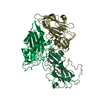
|
|---|---|
| 1 | x 60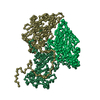
|
- Components
Components
| #1: Protein | Mass: 33562.785 Da / Num. of mol.: 1 / Mutation: VP1 T105M, VP1 F132L Source method: isolated from a genetically manipulated source Source: (gene. exp.)  Human poliovirus 3 / Variant: Saukett / Plasmid: pMVA_PV3 SC8_PV-IRES / Details (production host): Vaccinia virus transfer vector / Cell line (production host): BHK-21 Human poliovirus 3 / Variant: Saukett / Plasmid: pMVA_PV3 SC8_PV-IRES / Details (production host): Vaccinia virus transfer vector / Cell line (production host): BHK-21Production host:  References: UniProt: Q84895 |
|---|---|
| #2: Protein | Mass: 37623.023 Da / Num. of mol.: 1 / Mutation: VP2 L18I, VP2 L215M, VP2 D241E, VP4 T67A Source method: isolated from a genetically manipulated source Details: Sequence is given for the VP0 polypeptide. Mutations are numbered according to sequence numbering for mature polypeptides VP2 and VP4. Source: (gene. exp.)  Human poliovirus 3 / Variant: Saukett / Plasmid: pMVA_PV3 SC8_PV-IRES / Details (production host): Vaccinia virus transfer vector / Cell line (production host): BHK-21 Human poliovirus 3 / Variant: Saukett / Plasmid: pMVA_PV3 SC8_PV-IRES / Details (production host): Vaccinia virus transfer vector / Cell line (production host): BHK-21Production host:  References: UniProt: Q84895, UniProt: P03302*PLUS |
| #3: Protein | Mass: 26315.100 Da / Num. of mol.: 1 / Mutation: VP3 H19Y, VP3 L85F Source method: isolated from a genetically manipulated source Source: (gene. exp.)  Human poliovirus 3 / Variant: Saukett / Plasmid: pMVA_PV3 SC8_PV-IRES / Details (production host): Vaccinia virus transfer vector / Cell line (production host): BHK-21 Human poliovirus 3 / Variant: Saukett / Plasmid: pMVA_PV3 SC8_PV-IRES / Details (production host): Vaccinia virus transfer vector / Cell line (production host): BHK-21Production host:  References: UniProt: Q84895, UniProt: P03302*PLUS |
| #4: Chemical | ChemComp-SPH / |
| Has ligand of interest | N |
-Experimental details
-Experiment
| Experiment | Method: ELECTRON MICROSCOPY |
|---|---|
| EM experiment | Aggregation state: PARTICLE / 3D reconstruction method: single particle reconstruction |
- Sample preparation
Sample preparation
| Component | Name: Human poliovirus 3 / Type: VIRUS Details: Recombinantly expressed virus-like particle of PV3 (strain Saukett). Entity ID: #1-#3 / Source: RECOMBINANT | ||||||||||||
|---|---|---|---|---|---|---|---|---|---|---|---|---|---|
| Molecular weight | Value: 5.85 MDa / Experimental value: NO | ||||||||||||
| Source (natural) | Organism:  Human poliovirus 3 / Strain: Saukett Human poliovirus 3 / Strain: Saukett | ||||||||||||
| Source (recombinant) | Organism:  Cell: BHK-21 / Plasmid: pMVA_PV3 SC8_PV-IRES | ||||||||||||
| Details of virus | Empty: YES / Enveloped: NO / Isolate: SEROTYPE / Type: VIRUS-LIKE PARTICLE | ||||||||||||
| Natural host | Organism: Homo sapiens | ||||||||||||
| Virus shell | Name: Virus shell 1 / Diameter: 310 nm / Triangulation number (T number): 1 | ||||||||||||
| Buffer solution | pH: 7 / Details: 1 x DPBS, 20 mM EDTA, pH 7.0 | ||||||||||||
| Buffer component |
| ||||||||||||
| Specimen | Conc.: 1 mg/ml / Embedding applied: NO / Shadowing applied: NO / Staining applied: NO / Vitrification applied: YES / Details: Recombinantly expressed VLP of PV3. | ||||||||||||
| Specimen support | Details: The specific type of grid used was Ultra-thin carbon support film, 3nm - on lacey carbon AGS187-4 from Agar Scientific. Grid material: COPPER / Grid mesh size: 400 divisions/in. / Grid type: C-flat | ||||||||||||
| Vitrification | Instrument: FEI VITROBOT MARK IV / Cryogen name: ETHANE / Humidity: 100 % / Chamber temperature: 277.15 K Details: Double blotting with 4 ul of sample, followed by 4 second blot, before plunging. |
- Electron microscopy imaging
Electron microscopy imaging
| Experimental equipment |  Model: Tecnai Polara / Image courtesy: FEI Company |
|---|---|
| Microscopy | Model: FEI POLARA 300 |
| Electron gun | Electron source:  FIELD EMISSION GUN / Accelerating voltage: 300 kV / Illumination mode: FLOOD BEAM FIELD EMISSION GUN / Accelerating voltage: 300 kV / Illumination mode: FLOOD BEAM |
| Electron lens | Mode: BRIGHT FIELD / Nominal magnification: 160000 X / Calibrated magnification: 37037 X / Nominal defocus max: 3500 nm / Nominal defocus min: 1500 nm / Cs: 2.7 mm / C2 aperture diameter: 100 µm |
| Specimen holder | Specimen holder model: GATAN LIQUID NITROGEN |
| Image recording | Average exposure time: 5 sec. / Electron dose: 40 e/Å2 / Detector mode: COUNTING / Film or detector model: GATAN K2 SUMMIT (4k x 4k) / Num. of grids imaged: 2 / Num. of real images: 1465 |
| EM imaging optics | Energyfilter name: GIF Quantum LS / Energyfilter slit width: 20 eV |
| Image scans | Sampling size: 5 µm / Movie frames/image: 25 / Used frames/image: 1-25 |
- Processing
Processing
| Software |
| ||||||||||||||||||||||||||||||||||||||||||||||||||
|---|---|---|---|---|---|---|---|---|---|---|---|---|---|---|---|---|---|---|---|---|---|---|---|---|---|---|---|---|---|---|---|---|---|---|---|---|---|---|---|---|---|---|---|---|---|---|---|---|---|---|---|
| EM software |
| ||||||||||||||||||||||||||||||||||||||||||||||||||
| Image processing | Details: Pixels size was 1.35 A/pixel | ||||||||||||||||||||||||||||||||||||||||||||||||||
| CTF correction | Type: PHASE FLIPPING AND AMPLITUDE CORRECTION | ||||||||||||||||||||||||||||||||||||||||||||||||||
| Particle selection | Num. of particles selected: 14021 | ||||||||||||||||||||||||||||||||||||||||||||||||||
| Symmetry | Point symmetry: I (icosahedral) | ||||||||||||||||||||||||||||||||||||||||||||||||||
| 3D reconstruction | Resolution: 3 Å / Resolution method: FSC 0.143 CUT-OFF / Num. of particles: 9630 / Algorithm: BACK PROJECTION Details: Final reconstruction was sharpened with Post-processing in RELION using an inverse B-factor of -82.6 Angstroms. Num. of class averages: 1 / Symmetry type: POINT | ||||||||||||||||||||||||||||||||||||||||||||||||||
| Atomic model building | Protocol: RIGID BODY FIT / Space: REAL / Target criteria: Correlation coefficient Details: Initial model was rigid body fitted using UCSF chimera, and the refined in real space using Phenix_real.space.refine. | ||||||||||||||||||||||||||||||||||||||||||||||||||
| Atomic model building | PDB-ID: 5O5B Accession code: 5O5B / Source name: PDB / Type: experimental model | ||||||||||||||||||||||||||||||||||||||||||||||||||
| Refinement | Cross valid method: NONE Stereochemistry target values: GeoStd + Monomer Library + CDL v1.2 | ||||||||||||||||||||||||||||||||||||||||||||||||||
| Displacement parameters | Biso mean: 30.77 Å2 | ||||||||||||||||||||||||||||||||||||||||||||||||||
| Refine LS restraints |
|
 Movie
Movie Controller
Controller


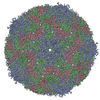
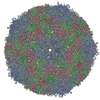
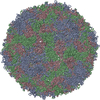
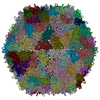
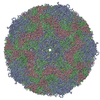
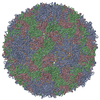
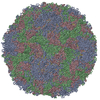
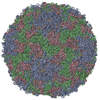

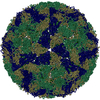
 PDBj
PDBj

